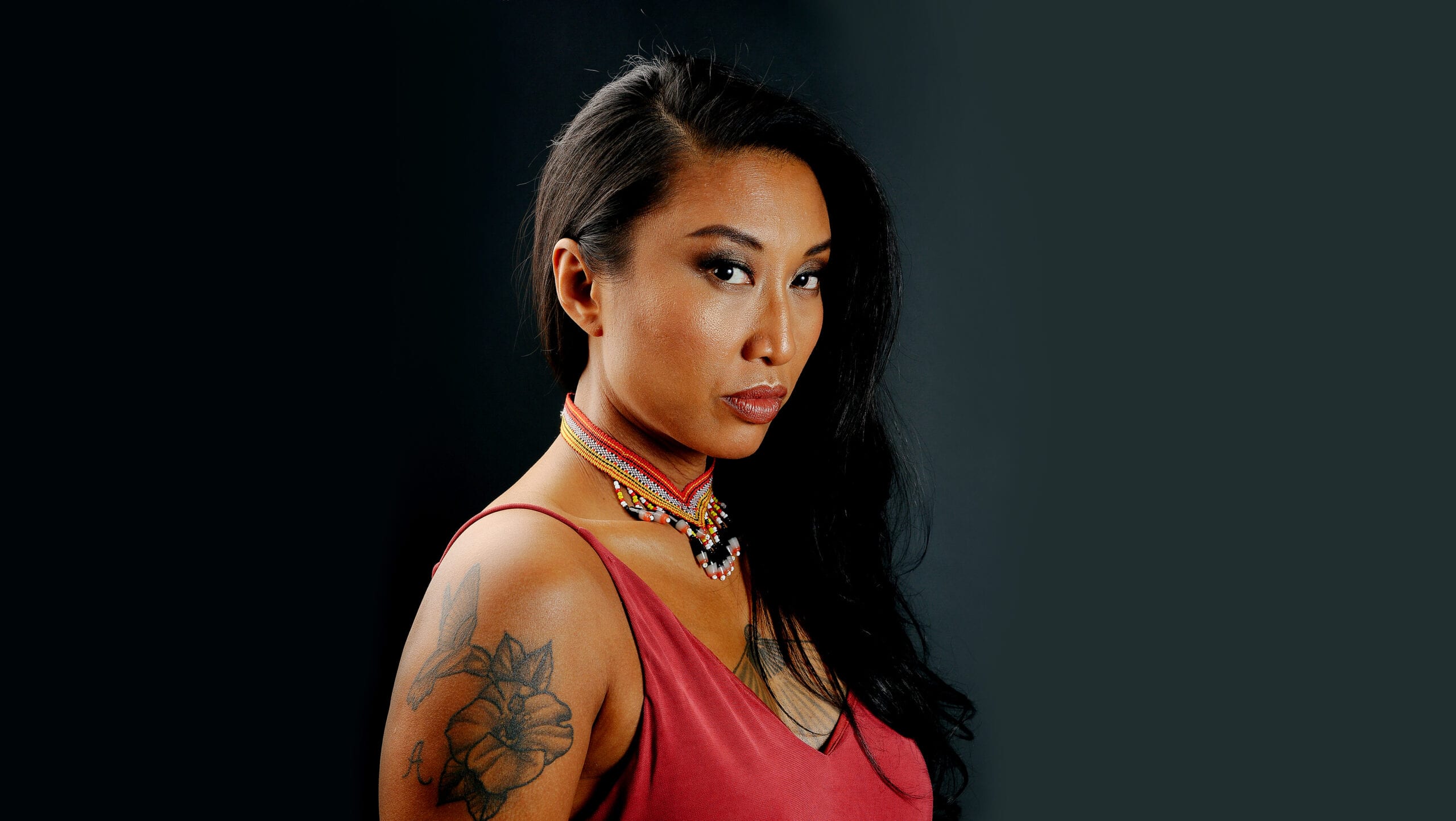The Toronto of Catherine Hernandez’s gripping new novel, Crosshairs, is immediately, specifically and vividly familiar. There’s the bookstore I’ve spent hours browsing in; there’s the theatre where I’ve seen hundreds of shows. Kay, a young, queer, Black and Filipino drag queen, wanders the same downtown streets, inhabits the same over-priced apartments, performs for tips in the same cramped venues and falls in love in the same noisy bars that so many of the city’s LGBTQ2 people have before him.
But his Toronto is under siege. A series of environmental catastrophes and the rise of an authoritarian regime has turned the near-future city into a dystopia. Lakes and rivers are poisoned. Thousands of displaced people live in rough shelters. Those deemed “The Other”—immigrants, disabled people, queer and trans people, Black, brown and Indigenous people—are rounded up and sent to concentration camps. Kay is forced underground and then is on the run.
Arriving, as it does, in the middle of a global pandemic, political and economic upheaval and mass demonstrations for racial justice, Crosshairs feels all at once urgent, uncomfortably prescient and glinting with hope. (Not all is yet broken in Kay’s world; a resistance is on the rise.) Like other authors whose recently released books about plagues and apocalypses were conceived as fantasies years ago, Hernandez hadn’t anticipated that her speculative fiction would seem so very real in the autumn of 2020.
A playwright and author whose critically acclaimed 2017 debut novel, Scarborough, is currently being adapted into a film, she explains that the genesis of Crosshairs came from another kind of tragedy. She began to write it in 2016, following the mass shooting at the Pulse nightclub in Orlando, Florida. The bar was hosting its weekly Latin night, and most of the 49 people killed and the 53 wounded were brown and Black. “I was thinking about the QTBIPOC community and our safety,” Hernandez says. “I wondered, ‘How safe are we right now?’ And the answer was, ‘Not really, not at all.’” Writing Crosshairs, she says, was a way to process those feelings of fear and grief, and to imagine possible new futures.
I interviewed Hernandez by video chat in early September, just after Crosshairs came out in Canada (its U.S. release is Dec. 8). We talked about sensitivity readers, allyship, drag culture and the necessity of pleasure.
When you spoke with Xtra last year, you were just finishing Crosshairs and the world was in a very different place. How have you and your family been coping through these past six months?
Here in Toronto, we’re very blessed to live so close to the lake and to have a space for us to walk. My partner and I usually get up around 7:00 a.m. and hit the shoreline. At first, when it was still rainy and cold back in March, my partner was going alone. And then they said, “Listen, I really think you should join me. I think we’re going to need this.” And of course, when you have a therapist as a partner, maybe they know something about emotional health!
I’m also grateful that I have a very independent 16-year-old daughter who is really good at managing when she needs solitude and when she needs to be around friends, and how to do so safely. At the same time, as my partner describes parenting at this time, it feels like you’re laying down the track just as the train is approaching. All of the trajectories that we assumed were going to be there for our youth are not there anymore.
That feels like a good segue to Crosshairs, which is set in an alternate future but now doesn’t seem so far from our current reality.
It does feel like it’s the reality unfolding now. That’s what’s so scary. You know, there were so many times where I wrote a passage and was like, “Oh my gosh, that’s so outrageous.”
There’s a scene where a character is sitting on the edge of Riverdale Park, looking out over the skyline, and the whole bowl of the park is a tent city filled with homeless folks. At the time I was writing it, I wondered if that was a bit too much. Then, the other day, I passed by another park that was full of tents of all the people being displaced because of COVID-19. Homelessness was already an issue in Toronto, it’s just so much more acute now. My heart broke. My book is fiction, but it feels like I was documenting the way things are now.
Two of the themes threaded throughout the book are denial and complicity. Those feel very relevant to this moment, as many people with privilege are grappling with issues like economic and racial injustice for the first time—whether that’s because of the inequality that the pandemic has laid bare, or because of the current movements against racism and white supremacy. How do you think people can move from awareness to action?
I want people to believe with their entire bodies that we all deserve to live and love, and that we should all have access to the freedoms and privilege that a lot of folks who are wealthy, white, able-bodied, cisgender and straight have had for centuries. And I think that what we’re seeing right now is the price that we pay when we believe that keeping the peace and getting along should be our main goal. That’s not the goal. Change is the goal.
True allyship means to help make sure that people from communities [that have been denied access] are actually making decisions and are in leadership roles. And that [process of giving up power] can hurt. But true allyship means that you have to make decisions sometimes that are not in your personal interest, but are in the interest of collective change.
You employed sensitivity readers for Crosshairs. Could you talk about how you brought that into the process of writing the novel?
I think a good objective for any writer to have if they want to adopt an anti-oppression framework in their work is to just know you’re going to make mistakes. You should be open to saying, “I’m sorry, I could do better.” And so for this book, I was dealing with characters that were not part of my community. Kay is part Filipino, like me. But the predominant narrative in his life is the fact that he is Black-presenting and he’s feminine.
I wanted to make sure that I was going to be doing right by the communities I was representing in the book and not further oppressing them. So I found some money and gathered a group of about 12 people to read the manuscript at different stages to let me know what I was doing right, what I was doing wrong—and I mention pay because you’re asking for emotional labour and there should be an exchange of some kind.
You have to be open to sensitivity readers telling you, “This is not your story.” That was something I had to be prepared for: that people would say, “No, please don’t write this book,” or “You could do better. These are the adjustments that I suggest.” I think sometimes people want sensitivity readers to just give them a little stamp of approval. I’ve seen it before, where sensitivity readers have been named as a way of [defending a book that receives criticism], with the author saying, “Well, this person said that it was okay.”
I’m also open to the fact that there are people from those communities who might read the book and still feel offended. And [that can] hurt. But that’s part of the process, to acknowledge those feelings. We all grew up in a society where we were taught that being wrong means that you failed and that you’re a horrible person—so the best thing to do is to not fail at all. For this, I knew that if I was going to ask people to read the book [and offer suggestions], I had to be open to change and open to being corrected. It was a wonderful process to go through and a very humbling one. And I’m very grateful to those 12 readers.
Kay is a drag performer, and there are these lovely interludes in the book that flash back to Kay learning to do drag. I know you’re a fan of drag. What does it mean for you?
If I ever went back to school to get a PhD, it would be in drag. I love how unapologetic and subversive it is. In the book, I wanted to look at drag as this uniquely queer art form that is about resistance, but how it is also a hotbed for some really intense racism and misogyny.
I always wanted to convey the feeling in the book that there is no one place that is magically safe—especially for Kay, who is both queer and Black. Drag is both a safe place [for Kay] but also a place where he is bombarded with anti-Black racism. There’s a great amount of appropriation and misogyny in that art form, and that’s something I wanted to show. It’s something that’s painful thing for us to acknowledge [in the queer community]: that you can be oppressed in one way but also be privileged [and oppressive] in another way.
That’s why drag is an important part of the novel: Where is Kay safe? And is he ever going to find safety, if the one place where he was safe never actually was a safe haven?
Now that the book is done and out in the world, what are you focusing on?
I was so, so moved by adrienne maree brown’s book Pleasure Activism. Everyone should read it. It definitely influenced the way that the novel was shaped, in that I needed my characters to experience moments of pleasure. I also needed to give myself pleasure.
Right now, because my health has taken a real downturn, I make sure that I’m feeding myself well, I’m moving my body, I’m drinking enough water and I’m trying as much as possible to get sleep and rest. adrienne maree brown writes that the revolution has to start with treating yourself with respect, because this world is seeking to shut you down. So the revolution, for me, is that I will not shut down, because I have given myself everything that I need to survive and thrive.
This interview was edited for length and clarity.


 Why you can trust Xtra
Why you can trust Xtra


